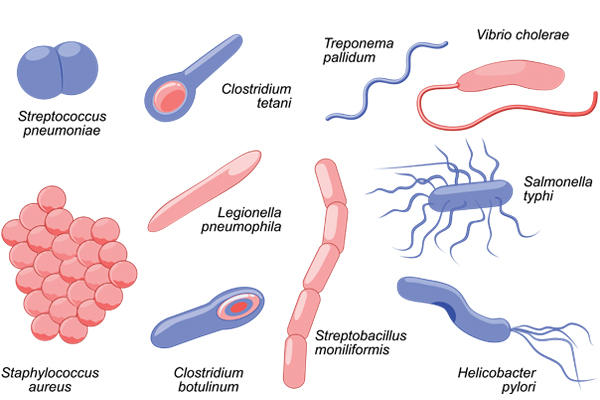| Bacteria
1. very small in size. |
Virus
1. smaller than bacteria |
| 2. can be seen under compound microscope. | 2. can be seen only under an electron microscope. |
| 3. shows metabolic activities. | 3. do not show metabolic activities. |
| 4. living cellular organisms. | 4. acellular particles. However, show living properties inside the host. |
| 5. cell wall is present except Mycoplasma. | 5. cell wall is absent. |
| 6. do not need a host organism for reproduction. | 6. need host organism for reproduction. |
| 7. DNA and RNA floating freely in cytoplasm. | 7. DNA/RNA strand enclosed inside a coat of protein. |
| 8. harmful as well as useful. | 8. usually harmful, though useful in genetic engineering. |
| 9. localized infection. | 9. systemic infection. |
| 10. possess cellular machinery. | 10. do not possess cellular machinery. |
| 11. treated by antibiotics. | 11. do not respond to antibiotics. |
| 12. ranges from 0.2-1.5 µ in diameter and 2-10 µ in length except few. | 12. ranges from 20-400 nm except few. |
| 13. bacterial illness commonly lasts longer than 10 days. | 13. viral infection lasts 2-10 days. |
| 14. bacterial illness notoriously causes a fever. | 14. viral infection may or may not causes fever. |
| 15. not known as biological puzzle. | 15. known as biological puzzle. |
| 16. food poisoning, gastritis, ulcers, meningitis, pneumonia, etc are bacterial diseases. | 16. AIDS, common cold, influenza, polio, etc are viral diseases. |
| 17. examples: Staphylococcus aureus, Vibrio cholera, Escherichia coli, etc.
Image source: microbiologysociety
|
17. examples: HIV, Hepatitis B virus, Rhino virus, Adeno virus, etc.
Image source: newsmedical
|
References:
i) https://microbiologysociety.org/why-microbiology-matters/what-is-microbiology/bacteria.html
ii) https://microbiologyinfo.com/differences-between-bacteria-and-viruses/
iii) https://www.diffen.com/difference/Bacteria_vs_Virus



